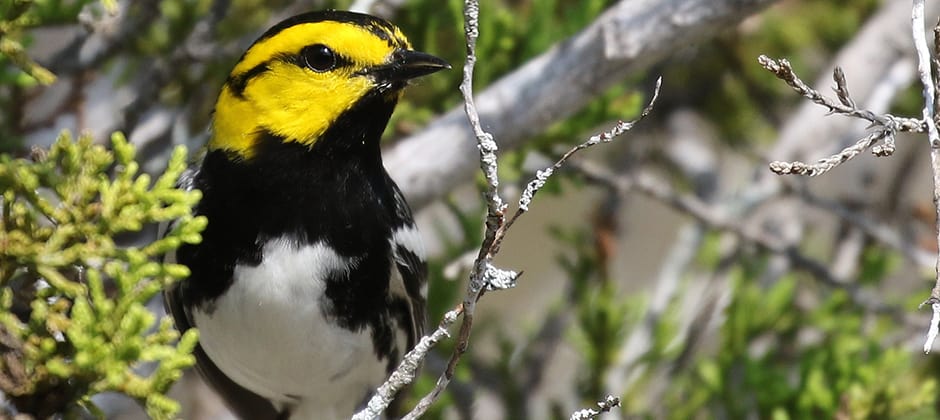Share this article
TWS2021: Age matters for golden-cheeked warblers
Older golden-cheeked warblers have better reproductive success than their younger counterparts, researchers found, as well has higher nest survival and overall productivity.
The golden-cheeked warbler (Setophaga chrysoparia) is a federally endangered, neotropical migrant songbird that breeds in Central Texas. It was listed in 1990 due to habitat loss and prefers mature juniper forests with oak, which is necessary for foraging. Its main predator is the Texas rat snake (Elaphe obsoleta lindheimeri).
“However, specific information has been lacking for this species,” said Gabriella Jukkala a graduate student at the University of Illinois in a presentation about her research on the species at The Wildlife Society’s 2021 virtual annual conference. For example, researchers don’t know much about how different age classes of the warblers reproduce. That knowledge is important, Jukkala said, to accurately model populations and reproductive success. “Understanding the contributing factors that may limit the success of young birds is important for informing species’ life history, as well as it could be used to develop some targeted management actions that may improve success of young birds,” she said.
Jukkala set out to determine if age is important for reproductive success and other factors for the species. To study this, she and her colleagues looked at “second-years”—younger, less wise birds—and “after-second-years”—wiser, older birds—on the Fort Hood military base in Texas, where a demographic monitoring program has been in place since 2000.
As part of the program, staff recorded color and the sex and age of both second-year and after-second-year birds, and mapped their territories. Beginning in 2016, they added nest cameras so researchers could peek inside. Jukkala and her colleagues also sampled vegetation around the nests in 2019 and 2020.
After compiling the data, the team compared older and younger males’ reproductive success and their probability of pairing with a female. They looked at nest survival, clutch size and the number of fledglings per nest, and they documented when the first egg of the first nest was laid, allowing them to compare age classes of males and females.
The researchers found that older males were more likely to pair with older females. Older males also had higher nest survival and productivity than younger males. In addition, older males and females initiated nesting earlier than younger birds. Overall, older warblers had high reproductive success and productivity.
Clutch and brood sizes, however, were similar for both older and younger females. That indicates that lower nest success is caused by nest failure, not the age of the females, Jukkala said. “The main cause of nest failure in the species is predation, which suggests that second-years are incurring greater predation in some way,” she said.
For males of any age, more oak meant less nest survival and productivity. That was especially true for younger warblers, which nested later and in more oak cover. Jukkala said that suggests conservation efforts may focus on restoring juniper in oak-dominated woodlands.
Younger birds’ nests were also getting preyed on earlier on the breeding season. “This could indicate that second-years are using poor nest sites, at least in their first breeding attempts, possibly due to inexperience at identifying good nest sites,” she said.
Jukkala said the findings show the importance of helping conserve younger birds’ nest sites. “We found that second-years can produce a similar number of young if their nest survives long enough to fledge,” she said. “Therefore, increasing second-year nest survival could contribute to population goals.”
Conference attendees can visit office hours for this contributed paper on Friday, Nov. 5 from 4 p.m. to 5 p.m. to learn more and ask questions.
Header Image: Younger golden-cheeked warblers have less reproductive success. Credit: Isaac Sanchez








